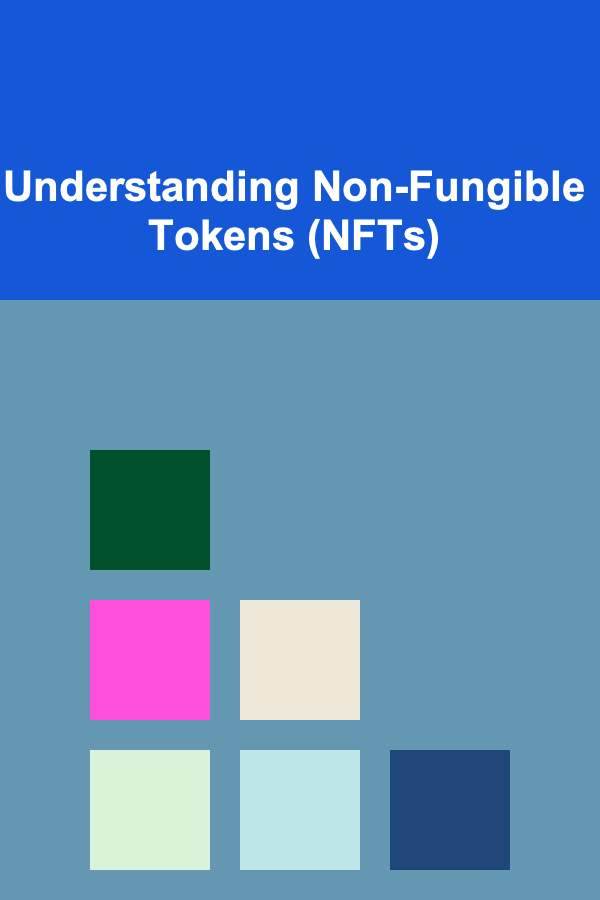
Understanding Non-Fungible Tokens (NFTs)
ebook include PDF & Audio bundle (Micro Guide)
$12.99$6.99
Limited Time Offer! Order within the next:

Non-Fungible Tokens, or NFTs, have rapidly emerged from relative obscurity to become a significant force in the digital world, capturing the attention of artists, collectors, investors, and technologists alike. While the concept might seem complex at first glance, the underlying principles are relatively straightforward. This article aims to provide a comprehensive understanding of NFTs, delving into their mechanics, applications, challenges, and future potential.
What are Non-Fungible Tokens?
To understand NFTs, it's crucial to first grasp the concept of fungibility. Fungible assets are those that can be easily exchanged for another identical asset, and still hold the same value. Think of a dollar bill -- it can be exchanged for another dollar bill, and both remain worth one dollar. Similarly, cryptocurrencies like Bitcoin are fungible; one Bitcoin is equivalent to another Bitcoin.
NFTs, on the other hand, are non-fungible. This means that each token is unique and cannot be replaced by another identical token. Think of a one-of-a-kind painting, a rare trading card, or a personalized digital collectible. Each has unique characteristics and a value that is not directly interchangeable with any other item. The individuality of each NFT is recorded on a blockchain, providing proof of ownership and authenticity.
Key Characteristics of NFTs:
- Uniqueness: Each NFT is distinct and represents a unique asset or piece of content.
- Indivisibility: NFTs cannot typically be divided into smaller units. You can't own a fraction of an NFT (although fractionalized NFTs are emerging, which we'll discuss later).
- Scarcity: The creator determines the scarcity of an NFT, which can be a single edition (1/1) or multiple editions (e.g., 100 copies). Controlled scarcity can drive up value.
- Ownership: NFTs provide verifiable proof of ownership recorded on a blockchain. This ownership is often immutable, meaning it cannot be altered or reversed.
- Transferability: NFTs can be bought, sold, and traded on various NFT marketplaces.
How do NFTs Work?
The foundation of NFTs is the blockchain, a distributed, decentralized, and often public ledger that records transactions in a secure and transparent manner. NFTs are typically minted on blockchains like Ethereum, Solana, Tezos, and Flow. Minting an NFT essentially creates a new entry in the blockchain that represents ownership of a specific digital or physical asset.
The Minting Process:
- Asset Creation: The creator of an NFT first creates the digital asset they want to tokenize. This could be a digital artwork, a song, a video, a virtual land plot, or even a representation of a physical object.
- Choosing a Blockchain: The creator chooses a blockchain to mint their NFT on. Ethereum is the most popular choice, but other blockchains like Solana, Tezos, and Flow offer faster transaction speeds and lower fees.
- Smart Contract Creation: The creator uses a smart contract to define the rules and properties of the NFT. A smart contract is a self-executing contract written in code that automatically enforces the terms of the agreement. The smart contract specifies the unique identifier of the NFT, its metadata (description, attributes, etc.), and the rules for transferring ownership.
- Minting the NFT: The creator uses a platform or tool to mint the NFT. This process involves paying a "gas fee" (transaction fee) to the blockchain network. The gas fee compensates the network for the computational effort required to process and record the transaction.
- NFT Storage: The NFT itself (or, more accurately, the metadata and a link to the actual asset) is stored either on the blockchain itself or on a decentralized storage network like IPFS (InterPlanetary File System). Storing the asset itself directly on the blockchain can be expensive, so IPFS is a common solution for storing the underlying content. The NFT's smart contract then points to the location of the asset on IPFS.
Smart Contracts and NFTs:
Smart contracts are fundamental to the functionality of NFTs. They enable:
- Proof of Ownership: The smart contract records the owner of the NFT. This ownership is verifiable by anyone on the blockchain.
- Royalties: Smart contracts can be programmed to automatically distribute royalties to the original creator whenever the NFT is resold. This is a significant benefit for artists and creators, as they can continue to earn revenue from their work even after the initial sale.
- Programmability: Smart contracts can be programmed to include additional features and functionalities. For example, an NFT could be programmed to unlock exclusive content or experiences for its owner.
- Transparency: All transactions related to an NFT are recorded on the blockchain, making them transparent and auditable.
Applications of NFTs
While NFTs initially gained popularity in the art and collectibles space, their potential applications extend far beyond these areas. Here are some key applications of NFTs:
Digital Art and Collectibles:
This is where NFTs first gained traction. Artists can tokenize their digital art, music, videos, and other creations, selling them directly to collectors and bypassing traditional intermediaries like galleries and record labels. This allows artists to retain more control over their work and earn a larger share of the revenue. Examples include:
- Digital Artwork: Beeple's "Everydays: The First 5000 Days" sold for $69 million, showcasing the potential value of digital art NFTs.
- Collectibles: CryptoPunks and Bored Ape Yacht Club are examples of popular NFT collectible projects with significant community and investment value.
- Music: Musicians are using NFTs to sell exclusive tracks, albums, and access to concerts and events.
Gaming:
NFTs are revolutionizing the gaming industry by allowing players to own in-game assets as NFTs. This enables:
- True Ownership: Players truly own their in-game items, such as weapons, characters, and land, and can trade or sell them outside of the game ecosystem.
- Interoperability: NFTs can potentially be used across different games, allowing players to bring their assets from one game to another (although this is still in its early stages).
- Play-to-Earn: Games like Axie Infinity use NFTs to create play-to-earn models, where players can earn cryptocurrency by playing the game and trading NFTs.
Metaverse:
The metaverse, a persistent, shared virtual world, is a natural fit for NFTs. NFTs can be used to represent:
- Virtual Land: Platforms like Decentraland and The Sandbox allow users to buy and own virtual land as NFTs.
- Avatars and Wearables: Users can customize their avatars with unique NFT-based clothing and accessories.
- Virtual Assets: NFTs can represent virtual furniture, artwork, and other objects within the metaverse.
Real Estate:
While still in its early stages, NFTs have the potential to revolutionize the real estate industry by:
- Tokenizing Properties: Real estate properties can be tokenized into NFTs, making it easier to buy, sell, and transfer ownership.
- Fractional Ownership: NFTs can enable fractional ownership of real estate, allowing multiple investors to own a share of a property.
- Streamlining Transactions: NFTs can potentially reduce the paperwork and bureaucracy associated with real estate transactions.
Supply Chain Management:
NFTs can be used to track and verify the authenticity of products in a supply chain by:
- Tracking Products: Each product can be represented by an NFT, allowing for tracking its origin, manufacturing process, and distribution.
- Verifying Authenticity: NFTs can help combat counterfeiting by providing a verifiable record of a product's authenticity.
- Improving Transparency: NFTs can make supply chains more transparent, allowing consumers to see the journey of a product from its source to their doorstep.
Ticketing and Events:
NFTs can be used to create unique and secure tickets for events by:
- Combating Scalping: NFT tickets can be programmed to prevent scalpers from reselling them at inflated prices.
- Providing Exclusive Access: NFT tickets can grant access to exclusive content, experiences, or merchandise.
- Creating Collectibles: NFT tickets can serve as digital collectibles, commemorating the event and providing lasting value for attendees.
Identity and Credentials:
NFTs can be used to represent digital identities and credentials by:
- Verifying Identity: NFTs can be used to verify a person's identity in a secure and tamper-proof manner.
- Storing Credentials: NFTs can store educational credentials, professional licenses, and other important documents.
- Controlling Data: NFTs can give individuals more control over their personal data.
Challenges and Criticisms of NFTs
Despite their potential, NFTs face several challenges and criticisms:
Environmental Impact:
Many blockchains, particularly Ethereum (before its transition to Proof-of-Stake), consume significant amounts of energy, raising concerns about their environmental impact. The minting and trading of NFTs on these blockchains contribute to this energy consumption. However, newer blockchains like Solana and Flow are designed to be more energy-efficient.
High Gas Fees:
Transaction fees (gas fees) on some blockchains, particularly Ethereum, can be very high, making it expensive to mint and trade NFTs. This can make NFTs inaccessible to many users.
Volatility and Speculation:
The NFT market is highly volatile, and prices can fluctuate dramatically. Many NFTs are purchased purely for speculative purposes, with buyers hoping to resell them for a profit. This can lead to unsustainable bubbles and crashes.
Intellectual Property Concerns:
The use of NFTs raises questions about intellectual property rights. It's important to ensure that the creator of an NFT has the right to tokenize the underlying asset. There have been instances of people minting NFTs of content that they do not own.
Security Risks:
The NFT space is vulnerable to scams, hacks, and phishing attacks. Users need to be careful about protecting their wallets and private keys. Additionally, smart contract vulnerabilities can be exploited to steal NFTs.
Lack of Regulation:
The NFT market is largely unregulated, which can create risks for buyers and sellers. There is a need for clear and consistent regulations to protect consumers and prevent fraud.
Centralization:
While blockchains are decentralized, many NFT marketplaces and platforms are centralized, meaning they are controlled by a single entity. This can create potential points of failure and censorship.
The Future of NFTs
Despite the challenges, NFTs have the potential to revolutionize various industries and applications. The future of NFTs is likely to involve:
Increased Adoption and Integration:
NFTs are likely to become more integrated into everyday life, with applications in gaming, entertainment, social media, and e-commerce.
Improved Scalability and Sustainability:
Efforts are underway to improve the scalability and sustainability of blockchains, making them more suitable for NFTs.
Greater Regulation and Consumer Protection:
Regulations are likely to be introduced to protect consumers and prevent fraud in the NFT market.
More Sophisticated Use Cases:
We can expect to see more sophisticated use cases for NFTs, such as fractionalized NFTs, dynamic NFTs (which change based on certain conditions), and NFTs that represent complex financial instruments.
Enhanced Interoperability:
Efforts are being made to improve the interoperability of NFTs across different platforms and blockchains, allowing users to seamlessly move their assets between different ecosystems.
Focus on Utility:
The focus is likely to shift from speculative trading to NFTs with real-world utility and value, such as access to exclusive content, experiences, or services.
Fractionalized NFTs:
Fractionalized NFTs represent ownership of a valuable NFT split into smaller, tradable ERC-20 tokens. This allows more people to invest in high-value NFTs that would otherwise be inaccessible due to their price. Platforms are emerging that specialize in fractionalizing NFTs, making them more liquid and accessible to a wider audience. This can also help to increase the liquidity of otherwise illiquid NFT assets.
Dynamic NFTs:
Dynamic NFTs (dNFTs) are NFTs that can change their properties or metadata based on external factors or events. This makes them much more versatile than static NFTs. For example, a dNFT could represent a concert ticket that changes its design after the concert, becoming a commemorative collectible. Or, a dNFT could represent a player's stats in a game, updating automatically as the player progresses.
NFTs and DAOs:
NFTs are increasingly being used in conjunction with Decentralized Autonomous Organizations (DAOs). NFTs can be used as membership tokens, granting access to DAO governance and benefits. For example, owning a particular NFT might give you the right to vote on proposals related to the DAO's activities.
Conclusion
Non-Fungible Tokens are a rapidly evolving technology with the potential to transform various industries. While they face challenges, their ability to represent unique digital and physical assets on a blockchain offers exciting opportunities for creators, collectors, and businesses. By understanding the underlying mechanics, applications, and challenges of NFTs, we can better navigate this emerging landscape and unlock its full potential. As the technology matures and regulations become clearer, NFTs are poised to play an increasingly important role in the digital economy.

How to Design User Interfaces (UI) for Apps
Read More
How to Set Up a Customer Appreciation Campaign: A Checklist for Building Stronger Relationships
Read More
How to Use Repurposed Items for Unique Bathroom Storage
Read More
How to Develop Early Spatial Awareness
Read More
10 Tips for Securing AI Research Funding
Read More
10 Tips for a Relationship To-Do List Focused on Emotional Intimacy
Read MoreOther Products

How to Design User Interfaces (UI) for Apps
Read More
How to Set Up a Customer Appreciation Campaign: A Checklist for Building Stronger Relationships
Read More
How to Use Repurposed Items for Unique Bathroom Storage
Read More
How to Develop Early Spatial Awareness
Read More
10 Tips for Securing AI Research Funding
Read More